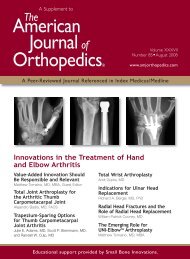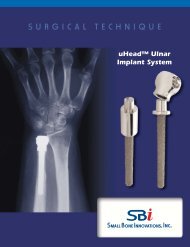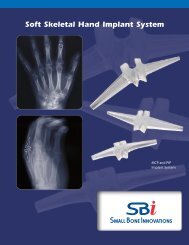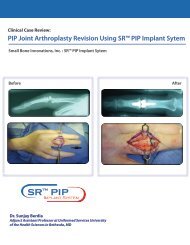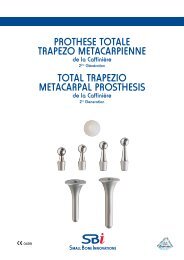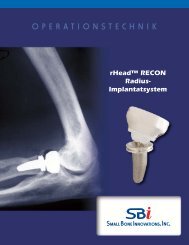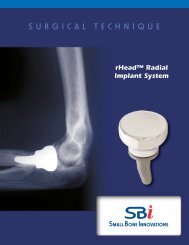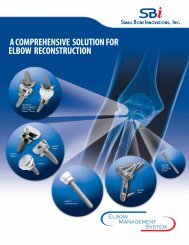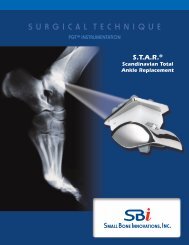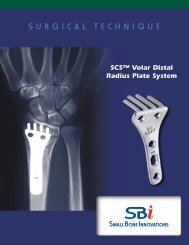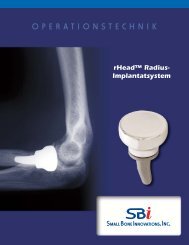Download the - Small Bone Innovations
Download the - Small Bone Innovations
Download the - Small Bone Innovations
You also want an ePaper? Increase the reach of your titles
YUMPU automatically turns print PDFs into web optimized ePapers that Google loves.
Risk/Benefit Decision by <strong>the</strong> Surgeon<br />
The judgement by a surgeon to use an implant is a risk/benefit decision which<br />
must take into account <strong>the</strong> patient’s needs, desires and expectations in<br />
addition to <strong>the</strong> surgeon’s knowledge of expected results and complications as<br />
well <strong>the</strong> alternative treatments. Therefore, surgeons must balance many<br />
considerations to achieve <strong>the</strong> best result in individual patients. Providing<br />
each patient scheduled for implant surgery with documented counseling of<br />
potential complications and alternatives, which may include non-implant<br />
procedure such as soft tissue reconstruction or arthrodesis, prior to surgery is<br />
necessary.<br />
Clinical Data<br />
Results of twenty-nine patients implanted with <strong>the</strong> device were reported. 2<br />
Replacement was performed for arthritis, failure of attempted arthrodesis,<br />
previous Silastic or total joint arthroplasty failure, or postparalytic fibrous<br />
ankylosis of <strong>the</strong> joint. Twenty-two patients had achieved a good range of<br />
painless motion at <strong>the</strong> time of publication (up to 7 years follow-up). Seven<br />
cases failed to achieve normal ROM due to significant muscle imbalance or<br />
soft tissue scarring and contracture. There were no reported cases of implant<br />
fracture or infection, but three cases of demonstrated loosening at <strong>the</strong><br />
cement-bone interface.<br />
In subsequent expanded publication including an additional 21 cases in <strong>the</strong><br />
series 1 ,most of <strong>the</strong> 50 patients showed a full range of motion within four<br />
weeks of suture removal and continued to demonstrate good long-term<br />
results. Full range of asymptomatic motion was achieved in 26 osteoarthritis<br />
patients with articular derangement. Five patients showed clinical or<br />
radiographic evidence of loosening. No cases of implant fracture, surface<br />
wear, fragmentation, or infection were seen.<br />
Adverse Events<br />
Adverse events in a published series of 50 patients included<br />
loosening, transient radial neuritis, cement extrusion injury to<br />
<strong>the</strong> palmar digital nerves and de Quervain’s tendinitis 1 .<br />
Potential adverse events reported with o<strong>the</strong>r finger joint<br />
pros<strong>the</strong>ses include loosening, fracture, discoloration, or<br />
infection of <strong>the</strong> implant.<br />
Injury to <strong>the</strong> surrounding nerve, blood vessels tendons, or soft<br />
tissues can occur as a consequence of implanting this device.<br />
EVENT<br />
NUMBER OF EVENTS (n=50)<br />
Loosening 5 (10.0%)<br />
Transient Radial Neuritis 2 (4.0%)<br />
Cement Extrusion Injury 1 (2.0%)<br />
De Quervain’s Tendinitis 6 (12.0%)<br />
Metal sensitivity reactions have been reported following joint<br />
replacement.<br />
8 Avanta CMC Implant System Surgical System





